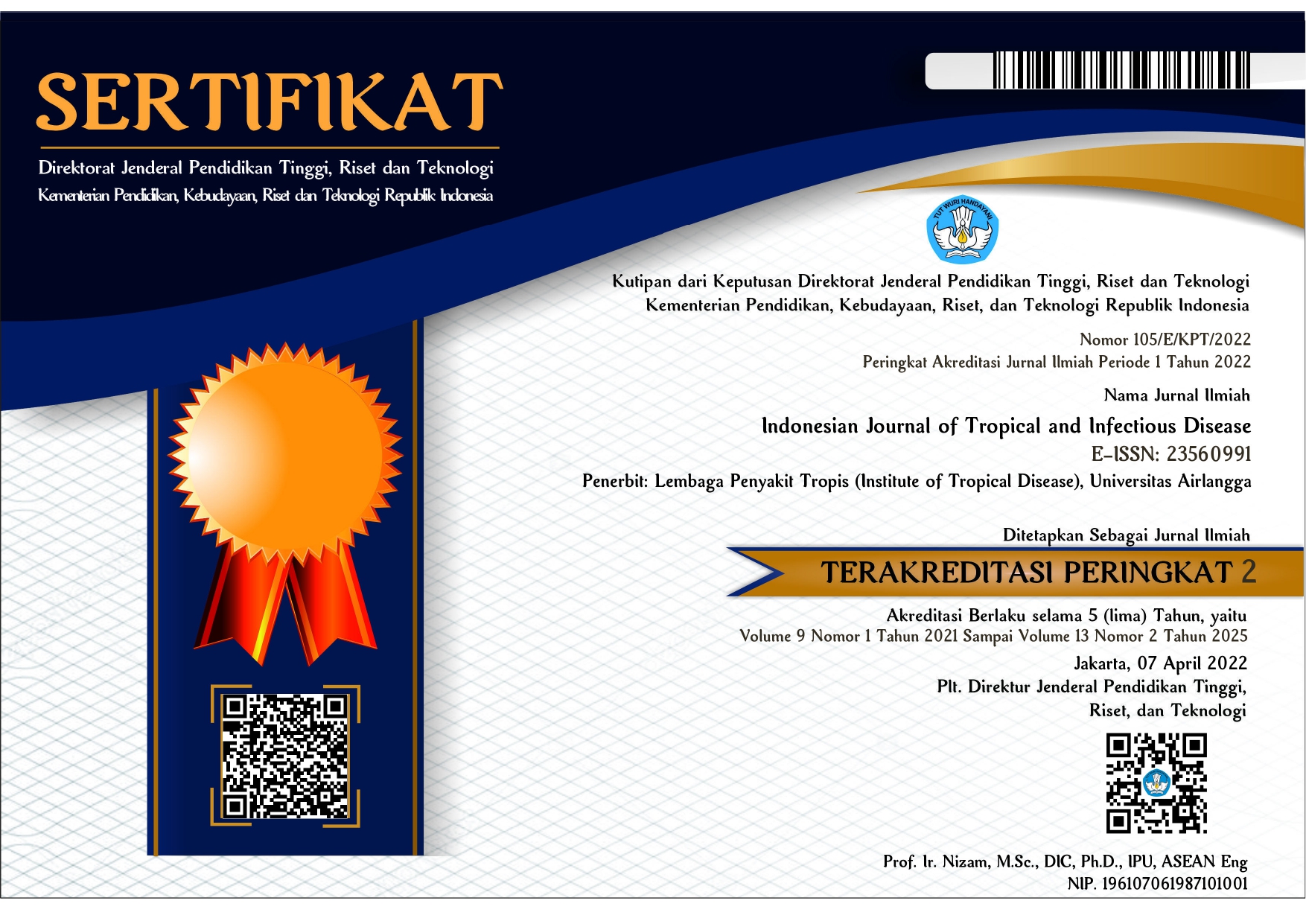Intervention Model for Pulmonary Tuberculosis (TB) with A Positive Acid-Fast Bacilli (AFB+) in Peukan Bada Sub-district, Aceh Besar Regency
Downloads
Pulmonary tuberculosis (TB) with positive Acid-Fast Bacilli (AFB+) remains one of the most transmissible infectious diseases worldwide. This disease poses a significant public health challenge in many countries. This study aimed to develop a risk-factor-based intervention model to reduce the incidence of Pulmonary TB (AFB+). A case-control approach was employed, with the case group comprising people diagnosed with Pulmonary TB (AFB+), and the control group consisting of non-TB individuals from the same neighborhoods. Binary logistic regression was used for bivariate analysis, and multivariate analysis utilized logistic regression. This study found that the social determinants model accounted for 34.9% of the variance in the incidence of Pulmonary TB (AFB+) (R² = 0.349). The biological determinants model showed an R² of 0.127, indicating that this model explains 12.7% of the variance in the disease. The third model, which focused on behavioral determinants, had an R² of 0.312, meaning that behavioral factors accounted for 31.2% of the variance. The fourth model, examining the physical condition of housing, showed an R² of 0.425, indicating that 42.5% of the variance in Pulmonary TB (AFB+) is explained by variables related to housing conditions. In conclusion, the physical condition of housing emerged as the strongest predictor of Pulmonary TB (AFB+). These findings suggest that improving housing conditions should be a key component of public health strategies to reduce the incidence of Pulmonary TB (AFB+). Targeted interventions to improve the household environment are crucial for reducing the risk and transmission of Pulmonary TB (AFB+).
World Health Organization (WHO). Global Tuberculosis Report 2023 [Internet]. Geneva; 2023. Available from: https://www.who.int/teams/global-programme-on-tuberculosis-andlung-health/tb-reports/globaltuberculosis-report-2023.
Flores GP, Alberto IRI, Eala MAB, Cañal JPA. The social determinants of tuberculosis in the Philippines. Lancet Glob Heal [Internet]. 2022;10:e38. doi: 10.1016/S2214-109X(21)00516-7.
Shimeles E, Enquselassie F, Aseffa A, Tilahun M, Mekonen A, Wondimagegn G, et al. Risk
factors for tuberculosis: A case– control study in Addis Ababa, Ethiopia. PLoS One [Internet]. 2019;14:e0214235. doi: 10.1371/journal.pone.0214235.
WHO. Implementing The End TB Strategy: The Essentials 2022 Update [Internet]. Geneva: WHO; 2022. Available from: https://www.who.int/publications/ i/item/9789240065093.
Ministry of Health of The Republic of Indonesia. National guidelines for tuberculosis control [Internet]. Jakarta: Ministry of Health of The Republic of Indonesia; 2011. Available from: https://repository.kemkes.go.id/book/124.
Aceh Provincial Health Office. The 2022 Aceh Health Profile [Internet]. Banda Aceh; 2023. Available from: https://dinkes.acehprov.go.id/lcontent/uploads/Profil_Kesehatan /dinkes_profile--REV-3--final.pdf.
Nyasulu P, Sikwese S, Chirwa T, Makanjee C, Mmanga M, Babalola J, et al. Knowledge, beliefs, and perceptions of tuberculosis among community members in Ntcheu district, Malawi. J Multidiscip Healthc [Internet]. 2018;Volume 11:375–389. doi: 10.2147/JMDH.S156949. Cited: in: : PMID: 30147328.
Asemahagn MA, Alene GD, Yimer SA. Geographic Accessibility, Readiness, and Barriers of Health Facilities to Offer Tuberculosis Services in East Gojjam Zone, Ethiopia: A Convergent Parallel Design. Res Rep Trop Med [Internet]. 2020;Volume 11:3–16. doi: 10.2147/RRTM.S233052. Cited: in: : PMID: 32099509.
Valencia-Aguirre S, Arroyave I, García-Basteiro AL. Educational level and tuberculosis mortality in Colombia: growing inequalities
and stagnation in reduction. Cad Saude Publica [Internet]. 2022;38. doi: 10.1590/0102- 311x00031721. Cited: in: : PMID: 35107505.
Da Silva V, Tigeh S, Wirawan N, Bakta M. The Relationship Between Education, Job, and Family Income with TB Medication Dropouts in Timor-Leste. Bali Med J [Internet]. 2016;5:97. doi: 10.15562/bmj.v5i2.223.
Gehlen M, Nicola MRC, Costa ERD, Cabral VK, De Quadros ELL, Chaves CO, et al. Geospatial intelligence and health analitycs: Its application and utility in a city with high tuberculosis incidence in Brazil. J Infect Public Health [Internet]. 2019;12:681–689. doi: 10.1016/j.jiph.2019.03.012. Cited: in: : PMID: 30956159.
Költringer FA, Annerstedt KS, Boccia D, Carter DJ, Rudgard WE. The social determinants of national tuberculosis incidence rates in 116 countries: a longitudinal ecological study between 2005–2015. BMC Public Health [Internet]. 2023;23:337. doi: 10.1186/s12889-023-15213-w.
Appiah MA, Arthur JA, Gborgblorvor D, Asampong E, Kye-Duodu G, Kamau EM, et al. Barriers to tuberculosis treatment adherence in high-burden tuberculosis settings in Ashanti region, Ghana: a qualitative study from patient’s perspective. BMC Public Health [Internet]. 2023;23:1317. doi: 10.1186/s12889-023-16259-6. Cited: in: : PMID: 24476154.
Su Y, Garcia Baena I, Harle AC, Crosby SW, Micah AE, Siroka A, et al. Tracking total spending on tuberculosis by source and function in 135 low-income and middleincome countries, 2000–17: a financial modelling study. Lancet Infect Dis [Internet]. 2020;20:929– 942. doi: 10.1016/S1473-3099(20)30124-9. Cited: in: : PMID: 32334658.
Hogan AB, Jewell BL, SherrardSmith E, Vesga JF, Watson OJ, Whittaker C, et al. Potential impact of the COVID-19 pandemic on HIV, tuberculosis, and malaria in low-income and middle-income countries: a modelling study. Lancet Glob Heal [Internet]. 2020;8:e1132–e1141. doi: 10.1016/S2214-109X(20)30288-6. Cited: in: : PMID: 32673577.
Saliba MF, Karam ZZ, Khayat M El, Koka E, Halwani DA, Ghanawi J, et al. Risk factors for silicotuberculosis among miners: a scoping review. BMC Public Health [Internet]. 2025;25:287. doi: 10.1186/s12889-025-21362-x. Cited: in: : PMID: 18450516.
Horton KC, MacPherson P, Houben RMGJ, White RG, Corbett EL. Sex Differences in Tuberculosis Burden and Notifications in Low- and Middle-Income Countries: A Systematic Review and Metaanalysis. Metcalfe JZ, editor. PLOS Med [Internet]. 2016;13:e1002119. doi: 10.1371/journal.pmed.1002119.
Ashaba C, Musoke D, Tsebeni Wafula S, Konde-Lule J. Stigma among tuberculosis patients and associated factors in urban slum populations in Uganda. Afr Health Sci [Internet]. 2021;21:1640–1650. doi: 10.4314/ahs.v21i4.18. Cited: in: : PMID: 35283968.
Chen X, Du L, Wu R, Xu J, Ji H, Zhang Y, et al. Tuberculosis-related stigma and its determinants in Dalian, Northeast China: a cross sectional study. BMC Public Health [Internet]. 2021;21:6. doi: 10.1186/s12889-020-10055-2. Cited: in: : PMID: 33397334.
Oladele DA, Balogun MR, Odeyemi K, Salako BL. A Comparative Study of Knowledge, Attitude, and Determinants of TuberculosisAssociated Stigma in Rural and Urban Communities of Lagos State, Nigeria. Apt AS, editor. Tuberc Res Treat [Internet]. 2020;2020:1–14. doi: 10.1155/2020/1964759. Cited: in: : PMID: 33343936.
Teo AKJ, Tan RKJ, Smyth C, Soltan V, Eng S, Ork C, et al. Characterizing and Measuring Tuberculosis Stigma in the Community: A Mixed-Methods Study in Cambodia. Open Forum Infect Dis [Internet]. 2020;7. doi: 10.1093/ofid/ofaa422. Cited: in: : PMID: 33134412.
Smith A, Herington E, Loshak H. Human Rights, Gender, Stigma and Discrimination Barriers to TB Services in Georgia [Internet]. Georgia: Canadian Agency for Drugs and Technologies in Health; 2021. Available from: https://pubmed.ncbi.nlm.nih.gov/34260166/.
Echazarreta A, Zerbini E, De Sandro J, Sáenz C, Yessi L, Saad R, et al. Tuberculosis and comorbidities in urban areas in Argentina. A gender and age perspective. Biomédica [Internet]. 2018; 38:180–188. doi: 10.7705/biomedica.v38i0.3904. Cited: in: : PMID: 30184347.
Junaid SA, Kanma-Okafor OJ, Olufunlayo TF, Odugbemi BA, Ozoh OB. Tuberculosis Stigma: Assessing Tuberculosis Knowledge, Attitude and Preventive Practices in Surulere, Lagos, Nigeria. Ann Afr Med [Internet]. 2021;20:184–192. doi: 10.4103/aam.aam_40_20. Cited: in: : PMID: 34558447.
Balakrishnan N, Md Monoto EM, Mohd Tohit N, Abdul Wahab A. Knowledge and perception of treatment among tuberculosis patients attending primary care clinics in Malaysia. J Infect Dev Ctries [Internet]. 2021;15:1205–1211. doi: 10.3855/jidc.12891. Cited: in: : PMID: 34516430.
Badane AA, Dedefo MG, Genamo ES, Bekele NA. Knowledge and Healthcare Seeking Behavior of Tuberculosis Patients attending Gimbi General Hospital, West Ethiopia. Ethiop J Health Sci [Internet]. 1970;28:529–538. doi: 10.4314/ejhs.v28i5.3. Cited: in: : PMID: 30607067.
Lin K, Kyaw C, Sone Y, Win S. Knowledge on tuberculosis among the members of a rural community in Myanmar. Int J Mycobacteriology [Internet]. 2017;6:274. doi: 10.4103/ijmy.ijmy_89_17. Cited: in: : PMID: 28776527.
Food and Agriculture Organization (FAO), AFAD, UNICEF, WFP, WHO. The State of Food Security and Nutrition in the World 2021 [Internet]. State Food Secur. Nutr. World 2021. FAO, IFAD, UNICEF, WFP and WHO; 2021. Available from: http://www.fao.org/documents/car d/en/c/cb4474en.
Lee GO, Paz-Soldan VA, RileyPowell AR, Gómez A, TarazonaMeza C, Villaizan Paliza K, et al. Food Choice and Dietary Intake among People with Tuberculosis in Peru: Implications for Improving Practice. Curr Dev Nutr [Internet]. 2020;4:nzaa001. doi: 10.1093/cdn/nzaa001. Cited: in: : PMID: 32025614.
Novilia P, Sri PW, Destri S. Modelling Of Pulmonary Tuberculosis Infection Based on Household Food Security Level in Surabaya Coastal Areas using Stratified Binary Logistic Regression. Semin Nas Mat IX [Internet]. Semarang: Faculty of Math and Natural Sciences; 2015. p. 436–442. Available from: https://journal.unnes.ac.id/sju/prisma/article/view/21434.
Susilaningrum D, Ulama BSS, Lathifah R, Susilaningrum D, Ulama BSS, Lathifah R. Mapping the Factors Affecting Household Food Security of Tuberculosis Patients in Coastal Region of Surabaya. MS&E. 2018;335:012053. doi: 10.1088/1757-899X/335/1/012053.
Moon D, Jeong D, Kang YA, Choi H. Gender differences in tuberculosis patients with comorbidity: A cross-sectional study using national surveillance data and national health insurance claims data in South Korea. Sharma BB, editor. PLoS One [Internet]. 2023;18:e0280678. doi: 10.1371/journal.pone.0280678. Cited: in: : PMID: 36662895.
Bates M, Marais BJ, Zumla A. Tuberculosis Comorbidity with Communicable and Noncommunicable Diseases. Cold Spring Harb Perspect Med [Internet]. 2015;5:a017889. doi: 10.1101/cshperspect.a017889. Cited: in: : PMID: 25659380.
Dzinamarira T, Imran M, Muvunyi CM. The Management of Infectious Diseases in Comorbidity with Tuberculosis. Medicina (B Aires)[Internet]. 2022;58:1406. doi: 10.3390/medicina58101406. Cited: in: : PMID: 36295567.
Sarker M, Barua M, Guerra F, Saha A, Aftab A, Latif AHMM, et al. Double Trouble: Prevalence and Factors Associated with Tuberculosis and Diabetes Comorbidity in Bangladesh. Hasnain SE, editor. PLoS One [Internet]. 2016;11:e0165396. doi: 10.1371/journal.pone.0165396. Cited: in: : PMID: 27798659.
Zafari P, Golpour M, Hafezi N, Bashash D, Esmaeili S, Tavakolinia N, et al. Tuberculosis comorbidity with rheumatoid arthritis: Gene signatures, associated biomarkers, and screening. IUBMB Life [Internet]. 2021;73:26–39. doi: 10.1002/iub.2413. Cited: in: : PMID: 33217772.
Silva DR, Muñoz-Torrico M, Duarte R, Galvão T, Bonini EH, Arbex FF, et al. Risk factors for tuberculosis: diabetes, smoking, alcohol use, and the use of other drugs. J Bras Pneumol [Internet]. 2018;44:145–152. doi: 10.1590/s1806-37562017000000443. Cited: in: : PMID: 29791552.
Tireh H, Heidarian Miri H, Khajavian N, Samiei A, Afzalaghaee M. Prevalence of Diabetes Mellitus and its Related Factors in Patients with Tuberculosis. Arch Iran Med [Internet]. 2022;25:835–840. doi: 10.34172/aim.2022.129. Cited: in: :PMID: 37543911.
Shaji B, Arun Thomas ET, Sasidharan PK. Tuberculosis control in India: Refocus on nutrition. Indian J Tuberc [Internet]. 2019;66:26-29. doi:10.1016/j.ijtb.2018.10.001. Cited: in: : PMID: 30797277.
Oxlade O, Huang C-C, Murray M. Estimating the Impact of Reducing Under-Nutrition on the Tuberculosis Epidemic in the Central Eastern States of India: A Dynamic Modeling Study. Nishiura H, editor. PLoS One [Internet]. 2015;10:e0128187. doi: 10.1371/journal.pone.0128187. Cited: in: : PMID: 26046649.
VanValkenburg A, Kaipilyawar V, Sarkar S, Lakshminarayanan S, Cintron C, Prakash Babu S, et al. Malnutrition leads to increased inflammation and expression of tuberculosis risk signatures in recently exposed household contacts of pulmonary tuberculosis. Front Immunol [Internet]. 2022;13. doi: 10.3389/fimmu.2022.1011166.
Akkerman OW, ter Beek L, Centis R, Maeurer M, Visca D, Muñoz-Torrico M, et al. Rehabilitation, optimized nutritional care, and boosting host internal milieu to improve longterm treatment outcomes in tuberculosis patients. Int J Infect Dis [Internet]. 2020;92:S10 S14. doi: 10.1016/j.ijid.2020.01.029.
Quan DH, Kwong AJ, Hansbro PM, Britton WJ. No smoke without fire: the impact of cigarette smoking on the immune control of tuberculosis. Eur Respir Rev [Internet]. 2022;31:210252. doi: 10.1183/16000617.0252-2021.
Aryanpur M, Hosseini M, Masjedi MR, Mortaz E, Tabarsi P, Soori H, et al. A randomized controlled trial of smoking cessation methods in patients newly-diagnosed with pulmonary tuberculosis. BMC Infect Dis [Internet]. 2016;16:369. doi: 10.1186/s12879-016-1727-4. Cited: in: : PMID: 27496096.
World Health Organization (WHO). Smoking and tuberculosis: a dangerous combination [Internet]. World Health Organization; 2018. Available from: https://www.who.int/europe/news/item/22-03-2018-smoking-andtuberculosis-a-dangerouscombination.
Fox GJ, Loan LP, Nhung NV, Loi NT, Sy DN, Britton WJ, et al. Barriers to adherence with tuberculosis contact investigation in six provinces of Vietnam: a nested case–control study. BMC Infect Dis [Internet]. 2015;15:103. doi: 10.1186/s12879-015-0816-0. Cited: in: : PMID: 25886411.
Fox GJ, Nhung N V, Sy DN, Hoa NLP, Anh LTN, Anh NT, et al. Household-Contact Investigation for Detection of Tuberculosis in Vietnam. N Engl J Med [Internet]. 2018;378:221–229. doi: 10.1056/NEJMoa1700209. Cited: in: : PMID: 29342390.
Lung T, Marks GB, Nhung NV, Anh NT, Hoa NLP, Anh LTN, et al. Household contact investigation for the detection of tuberculosis in Vietnam: economic evaluation of a clusterrandomised trial. Lancet Glob Heal [Internet]. 2019;7:e376–e384. doi: 10.1016/S2214- ]109X(18)30520-5. Cited: in: : PMID: 30784638.
Yuen CM, Seddon JA, Keshavjee S, Dodd PJ. Risk benefit analysis of tuberculosis infection testing for household contact management in high-burden countries: a mathematical modelling study. Lancet Glob Heal [Internet]. 2020;8:e672–e680. doi: 10.1016/S2214-109X(20)30075-9. Cited: in: : PMID: 32353315.
Khatana GH, Masoodi M, Amin M. Factors affecting applicability of “ home-based interventional model ” for active case finding among household contacts of index cases of pulmonary tuberculosis in Kashmir. Indian J Tuberc [Internet]. 2017;64:189–195. doi: 10.1016/j.ijtb.2017.01.011. Cited: in: : PMID: 28709487.
Dodd PJ, Looker C, Plumb ID, Bond V, Schaap A, Shanaube K, et al. Age- and Sex-Specific Social
Contact Patterns and Incidence of Mycobacterium tuberculosis Infection. Am J Epidemiol [Internet]. 2015;183:kwv160. doi: 10.1093/aje/kwv160. Cited: in: : PMID: 26646292.
Stang, Mallongi A, Dwinata I, Sumarni. Risk factor model for pulmonary tuberculosis occurrence in Makassar using spatial approach. Enfermería Clínica [Internet]. 2020;30:383–387. doi: 10.1016/j.enfcli.2019.10.105.
Susilaningrum D, Ulama BSS, Wulandari SP, Salamah M. The analysis of factors that affecting household food security of tuberculosis patients in Surabaya. J Phys Conf Ser [Internet]. 2019;1341:092014. doi: 10.1088/1742-6596/1341/9/092014.
Fitriani HU. The Differences of Ventilation Quality, Natural Lighting and House Wall Conditions to Pulmonary Tuberculosis Incidence in The Working Area of Sidomulyo Health Center, Kediri Regency. J Kesehat Lingkung [Internet]. 2020;12:39. doi: 10.20473/jkl.v12i1.2020.39-47. Cited: in: : PMID: 12435764.
Ardiyanti M, Sulistyawati S, Puratmaja Y. Spatial Analysis 0f Tuberculosis, Population and Housing Density in Yogyakarta City. Epidemiol Soc Heal Rev [Internet]. 2021;3:28–35. doi: 10.26555/eshr.v3i1.3629.
Pereira TV, Nogueira MC, Campos EMS. Spatial analysis of tuberculosis and its relationship with socioeconomic indicators in a medium-sized city in Minas Gerais. Rev Bras Epidemiol [Internet]. 2021;24. doi: 10.1590/1980- 549720210021.supl.1. Cited: in: : PMID: 33886894.
Mariana D, Hairuddin MC. Housing density, ventilation, and lighting in relation to pulmonary TB incidence in the Binanga Health Center working area, Mamuju District, West Sulawesi. J Kesehat Manarang [Internet]. 2018;3:75. doi: 10.33490/jkm.v3i2.40.
Xu M, Li Y, Liu B, Chen R, Sheng L, Yan S, et al. Temperature and humidity associated with increases in tuberculosis notifications: a timeseries study in Hong Kong. Epidemiol Infect [Internet]. 2021;149:e8. doi: 10.1017/S0950268820003040. Cited: in: : PMID: 33436107.
Li H, Ge M, Zhang M. Spatiotemporal distribution of tuberculosis and the effects of environmental factors in China. BMC Infect Dis [Internet]. 2022;22:565. doi: 10.1186/s12879-022-07539-4. Cited: in: : PMID: 35733132.
Zhang Y, Liu M, Wu SS, Jiang H, Zhang J, Wang S, et al. Spatial distribution of tuberculosis and its association with meteorological factors in mainland China. BMC Infect Dis [Internet]. 2019;19:379. doi: 10.1186/s12879-019-4008-1. Cited: in: : PMID: 31053104.
Madhona R, Ikhwan Z, Aminin F. Physical Environment Home and Incidence of TB Disease in Tanjungpinang District. Proc 1st Public Heal Int Conf (PHICo 2016) [Internet]. Paris, France: Atlantis Press; 2017. p. 397–401. Available from: http://www.atlantispress.com/php/paperdetails.php?id=25875904.
de Andrade KVF, Silva Nery J, Moreira Pescarini J, Ramond A, de Souza Teles Santos CA, Ichihara MY, et al. Geographic and socioeconomic factors associated with leprosy treatment default: An analysis from the 100 Million Brazilian Cohort. FrancoParedes C, editor. PLoS Negl Trop Dis [Internet]. 2019;13:e0007714. doi: 10.1371/journal.pntd.0007714. Cited: in: : PMID: 31490925.
Chen D, Lu H, Zhang S, Yin J, Liu X, Zhang Y, et al. The association between extreme temperature and pulmonary tuberculosis in Shandong Province, China, 2005–2016: a mixed method evaluation. BMC Infect Dis [Internet]. 2021;21:402. doi: 10.1186/s12879-021-06116-5. Cited: in: : PMID: 33933024.
Onozuka D, Hagihara A. The association of extreme temperatures and the incidence of tuberculosis in Japan. Int J Biometeorol [Internet]. 2015;59:1107–1114. doi: 10.1007/s00484-014-0924-3. Cited: in: : PMID: 25351361.
Gelaw Y, Yu W, Magalhães RS, Assefa Y, Williams G. Effect of temperature and altitude difference on tuberculosis notification: A systematic review. J Glob Infect Dis [Internet]. 2019;11:63. doi: 10.4103/jgid.jgid_95_18. Cited: in: : PMID: 31198309.
WHO. Housing and Health Guidelines [Internet]. Geneva: WHO; 2018. Available from: https://www.who.int/publications/i/item/9789241550376.
Mohidem NA, Osman M, Muharam FM, Elias SM, Shaharudin R, Hashim Z. Prediction of Tuberculosis Cases Based on Sociodemographic and Environmental Factors in Gombak, Selangor, Malaysia. Int J Mycobacteriology [Internet]. 2021;10:442–456. doi:
4103/ijmy.ijmy_182_21. Cited: in: : PMID: 34916466.
Copyright (c) 2025 Indonesian Journal of Tropical and Infectious Disease

This work is licensed under a Creative Commons Attribution-NonCommercial-ShareAlike 4.0 International License.
The Indonesian Journal of Tropical and Infectious Disease (IJTID) is a scientific peer-reviewed journal freely available to be accessed, downloaded, and used for research. All articles published in the IJTID are licensed under the Creative Commons Attribution-NonCommercial-ShareAlike 4.0 International License, which is under the following terms:
Attribution ” You must give appropriate credit, link to the license, and indicate if changes were made. You may do so reasonably, but not in any way that suggests the licensor endorses you or your use.
NonCommercial ” You may not use the material for commercial purposes.
ShareAlike ” If you remix, transform, or build upon the material, you must distribute your contributions under the same license as the original.
No additional restrictions ” You may not apply legal terms or technological measures that legally restrict others from doing anything the license permits.























